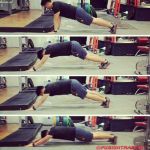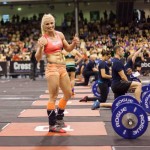
The Olympic weightlifting variations have been extremely popular to utilize in the sports performance training world. Many coaches and trainers look at Olympic weightlifters and see the extremely powerful, coordinated, athletes that they are and believe this training system can be adapted to develop their own athletes.
Skill Sets of a Weightlifter
The most popular skill set of a weightlifter is their power, it’s not uncommon to see big 105+ weightlifters able to have impressive jumping abilities. Weightlifters also have incredible strength, mobility, and development that many coaches prefer their athletes to have.
However, many look at the top weightlifters and fail to see that these athletes would more than likely excel in various other sports too. So did the weightlifting movements and variations develop their explosive ability or is that part of their genetic make up?
Vector Forces
A “Vector” is defined as: “a quantity that has magnitude and direction and that is commonly represented by a directed line segment whose length represents the magnitude and whose orientation in space represents the direction.”
To be an efficient Olympic weightlifter, the lifter must understand how to direct their force into the platform, for the majority this means that the force should be applied in a vertical direction.
This means the weightlifter is very efficient with application of force into the ground, which will have natural carry over to a vertical jump- IF they know how to efficiently lift. Keep in mind that a majority of weightlifters you see are usually international lifters = elite = training since they were very young (8-14yrs old) and are more than likely training x2 a days. At the minimum, there is a LOT of volume and a “survival” of the fittest system, meaning the system weeds out the “weak” for the genetically gifted.
Good Clean vs. Bad Clean
I want to take a step back and show the differences of force application with a good clean vs a bad clean
Good Clean
The good clean shows the lifter pushing into the ground in a vertical trajectory but also having a smooth first pull that set him up for an explosive and efficient 2nd/3rd pull and a perfectly timed catch.
Bad Clean
The bad clean you can see the lifter taking the force off the legs, and loading the back in flexion, pulling with the arm, bar crashing, and then catching the bar in flexion. This type of pull changes the mechanics when you get into the second pull, places undue stress on the lower back, and places the athlete at a much higher risk of injury during the pull and catch.
Don’t get me wrong, that’s a LOT of weight and a very powerful athlete. BUT what’s the risk vs. reward for this type of lifting?
Research

I started this post with every intention to have research based observations but many of the reviews I’ve read have a lot of missing variables.
For instance:
Powerlifting vs. Olympic Weightlifting
Channell et al (3) did a test on football players dividing them up into powerlifting and Olympic weightlifting groups. They concluded there wasn’t a meaningful difference in the vertical jump between the two groups:
Powerlifting group showed a vertical jump increase of 2.3% vs the Olympic weightlifting group with a 4.5% increase.
One issue is that the powerlifting group didn’t do much that mimicked the triple extension of a vertical jump vs the Olympic weightlifting group that pretty much mimics it in every way.
Weight Training vs Weight Training + Plyometrics
With that said, there are studies that show resistance training alone does not significantly increase your vertical jump vs. resistance training plus plyometric. Eliyahu et al (1) reported a 3% increase in a weight training group and 11% increase for a weight training + plyometric group of high school athletes. Big difference when you add in a plyometric element to your training.
Kettlebell vs Weightlifting
Otto et al (2) did a study on the effects of weightlifting vs. kettlebell training for vertical jump, strength, and body composition.
Vertical Jump: Kettlebell: +.22cm vs. Weightlifting: +.93cm
Not a huge increase in either but this test is limited since, the kettlebell group is limited by the weight of the kettlebell and the application of force leans more toward the horizontal vs vertical trajectory.
Practical Application
In the end, the research I found didn’t come up with much, however my practical experience as a weightlifting coach and strength and conditioning coach hopefully will have some positive input on your decision.
Every coach has to work with their limitations- time, space, equipment, experience and skill of the athlete, etc… If all things were equal, I’d personally stay away from the Olympic lifts and derivatives excluding the pulls. Here’s why:
Simplicity: in my experience teaching the lifts to NON-weightlifting athletes adds in too many complications. When we compare the simplicity of doing pulls or plyometrics vs power clean, snatch, jerk etc… it’s clear that the pulls and plyometrics movements are much easier to execute in the shortest amount of time. This is VERY important if you have your athletes for a few weeks out of the year.
If you’re at the college level, you’re more than likely limited by your coach to athlete ratio, example: having 20 athletes to one coach = the quality of training goes down. To top that, if you’re at a smaller school, the process of development of your athlete from freshman to senior is limited due to the amount of transfers, especially for talented athletes.

In my opinion, simplicity should be one of the top factors in a coaches program. Keep in mind that there is nothing wrong with simplicity, as Bruce Lee says “Simplicity is the key to brilliance”. The simplest programs are the easiest to execute and ones that can be executed with excellence.
Finally, for most coaches, the end goal is force application. We can simplify the movements, spend our time on other modalities, and get the same or more benefits through the pulls, med-ball tosses, weighted jump etc… versus the power clean, snatch, jerk etc…

Risk of Injury: weightlifters do reps and reps of the same movement, so the movements are second nature to them. However, this may not be the case for a lot of athletes and they may have limiting factors – i.e. mobility, injury, coordination, etc…
To add to this, most athletes lifts are atrocious, by the time they get into triple extension it’s more like they are doing a hip bump, pulling them into hyperextension = diminishes the purpose of the lift and increases risk of a lower back injury. Then the athlete will catch the bar in a super wide stance and catch the bar on the chest = no bueno.
HOWEVER…
The power cleans are really fun to do and if you find that team enjoys it and can do them effectively, I see no reason not to put them in the training program. Especially if this boosts the “fun factor” and increases team morale. This is where the coach should look at their teams/athletes abilities and decide what is right for their development.
Translation to Sport Improvement
In the end, I believe coaches need to look beyond the abilities of athletes from other sports and focus on what is right for their athletes and the limitations they have to work around. The fact is, you can develop power output through various plyometric and other modalities very effectively and with time efficiency.
Finally, we should remember that the weight-room is ONE small piece in our athletes overall development- energy systems, running mechanics, sport skill, reactiveness etc…
Train smart,
Research:
- Duke, S and Eliyahu, B , D. Plyometrics: optimizing athletic performance through the development of power as assessed by vertical leap ability: an observational study. Chiropr Sports Med 6: 10-15, 1992.
- Otto WH. Effects of weightlifting vs. kettlebell training on vertical jump, strength, and body composition. Journal of Strength and Conditioning Research. 1199-202, May 2012.
- Channell et al, “Effect of Olympic and traditional resistance training on vertical jump improvement in high school boys”, Journal of Strength and Conditioning Research, 2008, vol. 22(5), p. 1522–27.



 About the Author
About the Author







[…] Should Olympic Lifts Be Used to Develop Athletes? […]